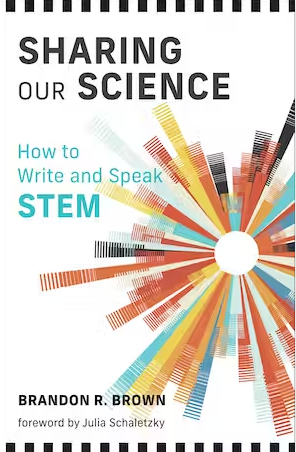4 Tips for STEM Writing
Scientist-turned-writing teacher Brandon R. Brown’s new book provides a blueprint for better STEM writing at all levels.

Writing about STEM is vital to help spread new scientific ideas and discoveries to students, experts, and the public at large. The problem, Brandon R. Brown says, is many STEM experts have never studied the craft of writing and communicating their work to the world.
“Most of us in scientific and engineering training get so little coursework related to communications,” says Brown, an author and professor of Physics and Astronomy, Arts and Sciences at the University of San Francisco.
After they graduate, many scientists are surprised by how much writing they have to do. “One of the sad consequences is we have a template for a lot of scientific writing that comes from lab reports,” Brown says. “You start with an introduction, and it's dry and historical, and then you get into methods, and then you get into your data. And then you get into so-called discussion and conclusions.”
Students pick up on these conventions and are often trained either directly or indirectly to write about science in this dry-as-the-desert manner. Brown seeks to reinvigorate scientific prose by providing professors, scientists, researchers, students, and others an alternative model for STEM writing in Sharing Our Science: How to Write and Speak STEM, which was published in August by MIT Press.
While his advice is aimed at professional scientists, educators can use his suggestions for conveying STEM subject matter to students and start encouraging their students to write about STEM in a more interesting way.
1) STEM Writing: Think Like a Fiction Writer

“I'm not preaching, having people hanging from cliffs or have loaded guns on the mantel,” Brown says. But when writing about science, more scientists and educators could use the storytelling techniques of fiction writers to enhance their work.
“It’s nothing revolutionary, but just taking concepts from fiction such as, 'Why on earth would anyone want to read past the first paragraph?' – keeping that reader in mind as a human being,” he says. “I think a lot of science and engineering communication assumes great interest on the part of the audience. And some domain experts will have to be interested. But there's a way we can surface our critical questions, or [explain] why the work is important that can help motivate the reader and make it a more engaging read.”
Tools and ideas to transform education. Sign up below.
2) Use Subheadings
Sometimes making STEM writing more engaging is an easy matter of adding some subheadings between different sections to help tell the story of the research being discussed.
“In today's world, people scan documents really quickly between meetings,” Brown says. “If they just see ‘introduction,’ ‘methods,’ and ‘discussion,’ that tells them nothing. The world, even in research journals, welcomes more descriptive subheadings that help tell a story at first glance.”
3) Use Better Sentences
In the book, Brown spends time stressing the importance of good sentence structure in writing rather than the long-winded, passive, prepositional phrases that constitute so much STEM writing today.
“I joke with scientists about how would you invite one another to lunch?” Brown says. “If you were doing it like you were writing a research paper it would take 10 minutes and be in passive voice and be very confusing.”
To avoid this type of confusing-speak, Brown recommends taking the advice of Francine Prose, an acclaimed novelist and writing guru, who urges writers to read what they write out loud and ask themselves if they would ever say something that way. If the answer is, “No,” then it’s time to re-write.
4) Highlight Narrative Tension
“One great professor I had, said, ‘Every plot boils down to something or someone having a goal and running into obstacles,'” Brown says. “I think scientific and engineering readers love the story of, ‘What obstacles did you come up with and how did you get around them?’”
Brown urges those writing about STEM to start with those obstacles. “'Here's what we want to do and here's why it's difficult.' Setting that so-called narrative tension up top can be great,” he says. “A lot of scientific writing and technical communication has that story in it, but submerged a little bit like at the end of the first two pages, or at the beginning of the second section of the paper. And I don't think it hurts anyone's format to surface that.”
Erik Ofgang is a Tech & Learning contributor. A journalist, author and educator, his work has appeared in The New York Times, the Washington Post, the Smithsonian, The Atlantic, and Associated Press. He currently teaches at Western Connecticut State University’s MFA program. While a staff writer at Connecticut Magazine he won a Society of Professional Journalism Award for his education reporting. He is interested in how humans learn and how technology can make that more effective.

